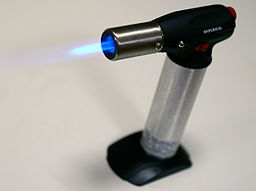Butane

Butane is an alkane with the chemical formula , as shown in Figure 2. As a type of hydrocarbon, it can undergo hydrocarbon combustion which releases heat energy. Butane is one of the hydrocarbon components of raw natural gas, which is a type of fossil fuel.[2] Butane is usually removed from natural gas before being shipped to customers, but then butane is sold separately as a fuel itself.
At typical temperatures and pressures butane is a gas and either by itself, or mixed with propane (), makes liquefied petroleum gas (LPG).[3] The percent of butane and propane in LPG varies based on what LPG is used for and the climate of where it is used.[3] LPG could even be entirely propane.
Butane is also commonly mixed with propane in camping fuel in order to maintain higher pressures at low temperatures.[4] Butane is as well one of the main components in lighter fluid and is commonly used in cigarette lighters, portable stoves and butane torches. Figure 1 shows a butane torch used for cooking purposes.
Properties

Below is a table of some of the basic properties of butane.
| Formula | C4H10 |
| Molar mass | 58.12 grams/mole |
| Energy density | 49.5 MJ/kg[6] |
| Melting Point | -138oC[7] |
| Boiling Point | -0.5oC[7] |
Combustion Reaction
Butane releases its chemical energy by undergoing hydrocarbon combustion. Below is a hydrocarbon combustion animation showing the net reaction that occurs when butane combines with oxygen.
The hydrocarbon combustion reaction releases heat energy and is an example of an exothermic reaction. The reaction also has a negative enthalpy change (ΔH) value.
For Further Reading
- Chemical energy
- Chemical bond
- Combustion
- Primary energy
- Energy conversion technology
- Or explore a random page
References
- ↑ [CC BY-SA 3.0 (http://creativecommons.org/licenses/by-sa/3.0) or GFDL (http://www.gnu.org/copyleft/fdl.html)], via Wikimedia Commons accessed 1/29/2015.
- ↑ “NATURAL GAS FAQs,” Pacific Northern Gas RSS. [Online]. Available: http://www.png.ca/natural-gas-faqs/. [Accessed: 24-May-2017]
- ↑ 3.0 3.1 Hahn, E. (2020). What is the Percentage of Propane and Butane in LPG Gas Mixture - Which Gas is Present in LPG. [online] Elgas.com.au. Available at: https://www.elgas.com.au/blog/1972-lpg-contains-which-gases-gases-present-in-lpg-gases-used [Accessed 26 Jan. 2020].
- ↑ MSR.(2014). MSR ISOPRO - Performance Boosting Fuel for your Canister Stove [Online]. Available: http://www.cascadedesigns.com/msr/stoves/stove-accessories/msr-isopro/product [February 16, 2015].
- ↑ "Butane-3D-space-filling". Licensed under Public Domain via Wikimedia Commons - http://commons.wikimedia.org/wiki/File:Butane-3D-space-filling.png#mediaviewer/File:Butane-3D-space-filling.png
- ↑ Glenn Elert. (2015). The Physics Hypertextbook - Chemical Potential Energy [Online]. Available: http://physics.info/energy-chemical/ [February 16, 2015].
- ↑ 7.0 7.1 Charles E. Ophardt. (2003). Virtual Chembook - Hydrocarbon Boiling Points [Online]. Available: http://www.elmhurst.edu/~chm/vchembook/501hcboilingpts.html [February 16,2015].

